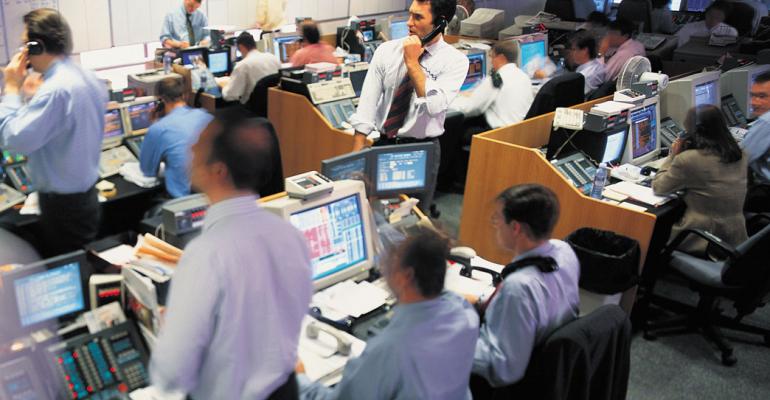As Hurricane Sandy brutally pounded the North East coast of America, fears of another Facebook or Flash Crash-style technology disaster played heavily on the decision to shut down US stock exchanges on Monday and Tuesday. These same fears played as big a role as other critical concerns such as staffing and employee safety at New York area brokerage houses, according to one trading expert and former New York Stock Exchange floor trader. The marts reopened Wednesday, the Dow Jones rising 18 points to 13,125 points in the first hour.
The closure didn’t disable every financial advisor. For some, Hurricane Sandy was a rare chance to provide some top-notch customer service. “As soon as they announced the closure late on Sunday night, I reached out to all my clients to give them a heads-up,” Brad Pine, a financial advisor and president of Bradford Pine Wealth Group in Garden City, NY., told REP. Pine was describing how he quickly fired off e-mails alerting his clients. “Any calls made by clients to my office were immediately forwarded to me cell,” he said.
Barry Larkin, the ex-Big Board floor trader, said it was not all smooth sailing at the NYSE. Larkin offered another reason why the NYSE agreed Sunday night to close U.S. stock and options marts. “It the NYSE had opened [successfully] without people on the floor, that could have been the final end of the NYSE floor,” Larkin, who kept in contact with former floor colleagues this week, speculated to REP. “It could prove that the NYSE could operate without human traders and that would be a huge deal.”
Larkin, a partner and founder of Storm Trend, a start-up trading and software developer in Fort Lauderdale, Fla., said if the NYSE had proceeded with its original plan – to close the floor and run an electronic trading session on Arca on Monday – the downside repercussions could have been immense. The NYSE could have been sued by exchange specialists for “taking away” their franchise, Larkin said. “The NYSE would be abandoning the specialist system,” he added. “And that is a system they insist on keeping. Some of my friends on the floor were worried about that [original plan], naturally.” NYSE spokesman, Richard Adamonis, dismissed suggestions the NYSE’s closure was connected to corporate fears that “designated market makers” – the modern term for NYSE specialists – would revolt or feel threatened if the Big Board had opened Monday on its electronic platform. “It’s absurd,” he said of the suggestion. “It’s obviously speculation, nothing would point to that.”
The decision to close the NYSE, the US stock and options marts for two days this week was reached by industry consensus and the involvement of the Securities and Exchange Commission, according to Adamonis. Many factors played into the decision, among them weather forecasting, Street staffing consideration -- and the ability of the markets to operate efficiently in a challenging environment.
The last time the NYSE was closed for two consecutive days because of severe weather conditions was for the Blizzard of 1888 –-- 124 years ago. By Wednesday, it was almost back to business as usual. "It's been very smooth," Duncan Niederauer, CEO of NYSE Euronext, told CNBC from the floor in lower Manhattan. “The market-making community is more than staffed enough to be open.” The former Goldman Sachs (NYSE: GS) manager added, “We jokingly said this morning we may be the only building south of Midtown that has water, lights and food.”
Officials at the Big Board had reason to be in a jovial mood on Wednesday. There was speculation and reports earlier of potential blow-ups and technology snafus in the making. Larkin amplified fears reported elsewhere. Wall Street’s patchwork quilt of electronic exchanges and trading platforms – including the NYSE and Nasdaq -- could have buckled in such an untested environment as Hurricane Sandy, he said. For one thing, some players could have been inundated with unusual activity and surges in volume, straining their systems. That could have potentially triggered glitches of the kind last seen during the Flash Crash, Nasdaq’s Facebook fiasco and the erratic trading that cost Knight Trading Group $461 million. “If one system, for example, ended up doing substantially more volume than normal, that could have crushed that system,” Larkin explained.
Still, for FAs like Brad Pine, Hurricane Sandy was an occasion to prove some mettle. “In this business it is important to have strong client relationships,” Pine said. “I am always accessible to my clients. Even if someone calls me and it goes to voice mail, I will call them back.”
Pine described how one client called him earlier this week as Hurricane Sandy was about to strike hard. His easy accessibility was appreciated. “Her husband had recently passed away and I spent some time talking to her,” he said. Pine also reached out to clients (and one prospect) who lived on the Jersey Shore to let them know he was there for them.
Other financial advisors also swung into action. Some took novel (and common sense) approaches to communications. UBS Wealth Management Americas closed more than 50 branches on Monday and Tuesday because of concerns for FAs safety and the safety of their colleagues, Karina Byrne, a UBS spokeswoman, told REP. Still, many kept in contact with clients through their mobile and e-mail communications. Byrne also noted that UBS operated a “buddy branch” system. Any client calls made to a branch closed by the storm was immediately re-routed to an open branch. “Clients would have felt no disruption to their services,” Byrne said.
The same could not be guaranteed to investors everywhere if the NYSE had opened on Monday and Tuesday, according to Larkin, the former NYSE trader. The potential disruptions to clients could have been catastrophic, he contended. “It could also have opened up a huge can of worms for the NYSE – it could have resulted in lawsuits from the specialists concerned about their livelihoods,” he added.





